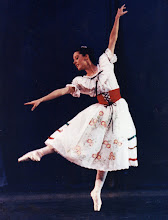 Did you ever have to diagram sentences when you were in school? I remember doing that, and realizing that every sentence has certain parts that are required and some that just add variety and interest. The same is true of combinations for ballet class. Every class needs to progress through pliés, tendus, degagés, rond de jambe, grand battement, and every combination has parts that should be included or can be added to make it more interesting. We shouldn't only work on our artistry during rehearsal and performance. Artistry begins in the classroom, and by adding dimension to your combinations you allow your students to experiment and grow. A good rule of thumb for most combinations is to keep it at an even number of phrases, so you'd have two sets of eight, four sets of eight, or eight sets of eight, for example. This simply makes sure you finish a combination at the end of a phrase rather than in the middle.
Did you ever have to diagram sentences when you were in school? I remember doing that, and realizing that every sentence has certain parts that are required and some that just add variety and interest. The same is true of combinations for ballet class. Every class needs to progress through pliés, tendus, degagés, rond de jambe, grand battement, and every combination has parts that should be included or can be added to make it more interesting. We shouldn't only work on our artistry during rehearsal and performance. Artistry begins in the classroom, and by adding dimension to your combinations you allow your students to experiment and grow. A good rule of thumb for most combinations is to keep it at an even number of phrases, so you'd have two sets of eight, four sets of eight, or eight sets of eight, for example. This simply makes sure you finish a combination at the end of a phrase rather than in the middle.Just as the progression of exercises at the barre generally alternate between slow and fast tempos to give the muscles a chance to stretch before contracting quickly again, it's possible to design your combinations in this way, too. I loved taking classes from teachers who knew how to add stretching to a fast degagé combination, or who added some double time rond de jambes in a rond de jambe à terre combination. One simple way of incorporating this into your combinations is to take the steps at a slower pace the first time through, and without changing the tempo of the music, move the steps into double time so they are twice as fast. You can do this also by turning a slower tendu combination into a faster degagé combination, or a faster degagé combination into a slower grand battement combination.
Another thing to remember when constructing your combinations is to use épaulement, or shouldering (head and arms). It's important to use the arms at the barre so that when dancers move into the center they don't look stiff and uncomfortable using their arms and head. Each combination can have a goal that contributes to the overall goal of that class. You may decide to devote a whole class on attitude. You can balance in attitude at the barre, practice embôité turns or attitude turns in the center, practice renversé, grand allegro with bent back leg. In a class like this you may do balançoire at the barre in attitude. A good teacher can take a specific movement and make a whole class out of it. Adding a balance to the end of a barre combination is always a good way to finish, because it allows the dancer time to stop and pull everything together for a moment before moving on to the next step or combination.
Here's a link to my new book of over 200 ballet combinations! Classical Ballet: Combinations for Ten Complete Advanced Classes





interesting points as ever !
ReplyDelete